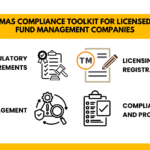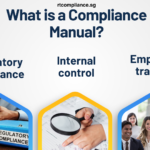How to Calculate AUM for Licensing in Singapore
Assets Under Management (AUM) means more in the financial world than just a way to check performance. It significantly affects which licenses and rules must be met, mainly in fund management. In Singapore, MAS reviews asset under management (AUM) to check the capability, qualification and compliance of licensed fund management firms.
The article explains what AUM means for Singapore’s fund management industry, how it is calculated for licensing, the MAS approach to defining AUM, the standards for reporting and the typical mistakes to avoid.
Understanding Assets Under Management (AUM) in Licensing
AUM is the worth of all assets being managed by a fund management company (FMC) for its clients. With aid’s fair share indicator, MAS is able to calculate:
- The question of whether a firm qualifies for RFMC or LFMC YARD depends on its type.
- When a firm does not violate its license agreement
- The firm’s needed base capital and risk requirements
- How often and how much a company must tell the SEC
As a rule, an RFMC is allowed to manage only S$250 million in AUM, but LFMCs and VCFMs are held to different criteria for size and risk control.
MAS Definition of AUM (Assets Under Management) for Licensing
The MAS describes AUM or Assets Under Management, as the total value of assets managed discretionarily by a fund manager, minus:
- Assets managed according to the client’s wishes
- Assets that are handled under an advisory agreement (where the manager does not have executive control)
- Their own assets that are not owned for the convenience of clients
With discretionary fund management, the fund manager gets full power to decide how to invest the funds, under an agreement.
Types of Assets Included When You Calculate AUM
When figuring AUM for licensing, a fund manager is required to count all discretionary assets, no matter what their class, investment method or position happens to be. Among the things to expect are:
- Listed equities
- Things like fixed income instruments
- Derivatives
- Private equity investments
- Purchasing real estate using funds or this mechanism
- If you have the option, you can add commodities and alterative assets to your portfolio.
MAS requires that the value assigned to assets under management is fair and that the manager’s authority to handle them is clearly recorded.
How to Calculate AUM for Licensing in Singapore
1. Identify Eligible Portfolios
The first step is to create a list of accounts and funds that the fund manager manages using full discretion. This includes:
- Discretionary mandates
- Investments coming from several sources
- Special Purpose Vehicles (SPVs), in which the manager has been given specific authority by contract
Do not include those clients and funds for which the firm does not control the investments.
2. Determine Fair Market Value of Assets
For all portfolios that are eligible, the system:
- Get the latest known price for any listed security.
- Unlisted securities should be valued using sensible methods, for example:
- Third-party appraisals
- Information about NAVs is provided by fund administrators.
- Sources outside the company confirmed the effectiveness of the models
Valuations should always reflect all requirements of accounting standards (for example, IFRS or SFRS) and updated either monthly or quarterly depending on what kind of assets they are.
3. Convert to SGD for Accurate AUM Reporting
You should convert the foreign currency value of your assets to Singapore Dollars (SGD) at the current or average exchange rate for the time of valuation.
4. Use Gross Basis for AUM Licensing Calculation
No deductions are made in calculating AUM for the alternate mutual association, regardless of associated client liabilities, leverage or fund expenses.
For example:
- No matter how much debt the fund has, its AUM is always S$300 million, not less.
5. Calculate AUM Rolling Averages for RFMC Licensing
No one RFMC should have assets under management higher than S$250 million based on the last 3 months’ average. This means:
- At the end of each of the last 3 calendar months, show the AUM for that month.
- You can get the average AUM by dividing by 3.
Understanding how to apply for RFMC license in Singapore with MAS includes being aware of such thresholds and staying compliant with ongoing regulatory obligations.

AUM Reporting Obligations to MAS for Licensing
All fund managers—RFMCs, LFMCs and VCFMs—have to file annual regulatory returns and may undergo inspections now and then. These submissions are greatly shaped by reference to AUM.
Key Reporting Forms for AUM in Singapore
- Please use Form 25A, an annual declaration, for RFMCs showing their AUMs.
- Use Form 1A when reporting operational and financial data from an LFMC.
- MAS 610 / MASNET advises: Use the standard returns section when facing larger funds
MAS expects all reported AUM figures to:
- Check the information with others in your group
- Whenever possible, always stick to having your financial statements audited.
- Explain tax filings in a way that matches requirements to clients or investors.
Special Considerations in AUM Calculation for Licensing in Singapore
Umbrella Funds and Sub-Funds AUM
If a multiple-sub-fund organization is managed, the Fund Manager must include the total gross value of all sub-fund assets controlled by the manager in the AUM calculation.
Delegated or Sub-Advised Portfolios
Even if the manager assigns some investments to another adviser and still makes the final decisions, all the assets counted towards the license are still linked to the manager’s license.
Even so, in the case where the firm only acts as a sub-adviser without discretionary authority, those assets are not counted as AUM for licensing reasons.
Calculating AUM for Funds Using Leverage
The amount under management is calculated by including all the liabilities when leverage (e.g., margin and derivatives) is applied. According to MAS, collecting positions into a group should be avoided for AUM reporting.
Common Mistakes in AUM Calculation
Some fund managers incorrectly state their AUM, usually happening because they misunderstand the information or have poor controls in place. Often, people experience the following difficulties:
- Why include advisory mandates in AUM when they have no investment decisions?
- Removing liabilities from AUM which lowers the number
- Letting AUM data for illiquid or private assets become out of date
- Problems with converting foreign currency for assets
- Steps include counting those funds whose clients are also part of the company network
Firms should ensure they count their AUM accurately and ask for help from outside compliance experts if they need it.
Implications of Misreporting AUM
If AUM reports are incorrect, it can attract serious penalties from the regulators.
- A license application may be delayed or rejected.
- Penalties placed by regulators
- A suspension or revocation of a driver’s license
- Plans that are required by law to be put in place
Forming an accurate and complete report is very important in MAS. Managers of funds should use only correct audit systems and must sign off on their figures of assets under management.
Conclusion:
AUM isn’t only a number to measure success; it also determines which licenses a fund manager is eligible for and how big their compliance tasks will be. In Singapore, the MAS explains what an AUM is, how to work out the total and how to report it.
Key takeaways:
- Only funds that are managed on a discretionary basis are considered in AUM.
- Every valuation should use fair market value on a gross basis.
- The use of AUM is important for licensing, preparing for audits and managing money.
- The S$250 million limit places a need on RFMCs to keep an eye on assets under management.
- Properly reporting to MAS will prevent you from facing enforcement penalties.
To meet the rules, fund managers are urged to use strong internal procedures, periodically check their systems and check with officials if needed. Following these guidelines, companies preserve their integrity, win investor confidence and strive to respect Singapore’s regulations.




